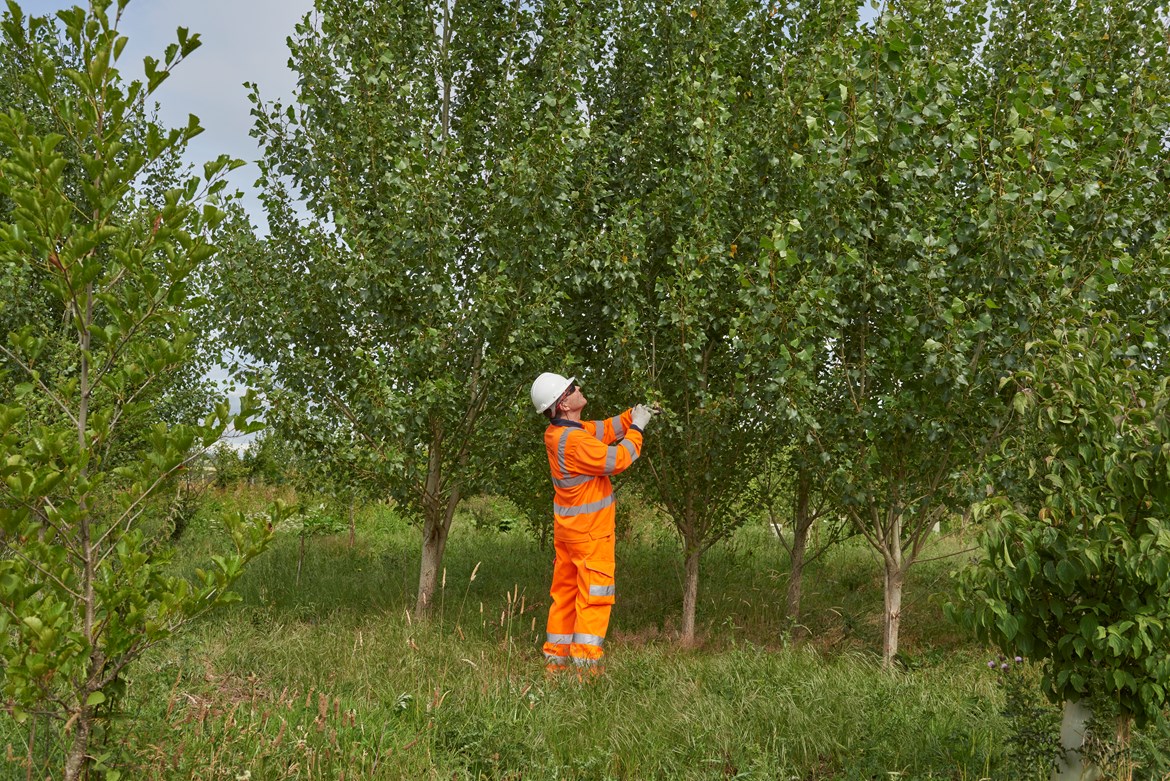During National Tree Week, and as HS2 starts its next season of tree planting, the project is celebrating the first five years of habitat creation on Phase One.
Over 845,000 trees have now been planted and maintained including native species such as hazel, hawthorn, oak, blackthorn and silver birch. Ecology companies along the Phase One route have created 119 new wildlife sites which are already thriving homes for wildlife, ensuring HS2 protects the country’s precious biodiversity and leaves a lasting legacy for local communities.
Many acres of new wetland, heathland and meadow have been created and HS2 has also built homes for wildlife including 2,000 bat boxes either within HS2’s wildlife sites or in existing nearby woodlands.
Around 150 hibernacula and 65 reptile banks have been created which provide new homes for reptiles and amphibians, helping local wildlife thrive and support delicately balanced local ecosystems. Over 160 barn owl boxes and 29 artificial badger setts have also been created and thousands of newts have been successfully rehomed.
David Prys-Jones, Biodiversity Lead at HS2 Ltd said:
“We’re now five years into our extensive environment programme to create more than 33 square kilometres of new wildlife habitats along the HS2 route, the equivalent of 23 new Hyde Parks lining the spine of the country.
“In this year’s National Tree Week, it’s fantastic to see our wildlife habitats thriving, but this is really just the beginning. Over the coming years, our ecology contractors will continue to create more habitats to sustain healthy populations of UK flora and fauna, providing a network of bigger, better-connected, climate resilient habitats and new green spaces for wildlife and people to enjoy.”
As one of Britain’s biggest environment projects, HS2 is creating many jobs and skills opportunities for ecologists right across the country. Numerous ecology companies have worked on HS2’s environment programme so far, including Kenilworth-based SME Thomson Environmental who joined the project in 2017. The company employs local people, with around 30 people working on HS2, and has seen a 20 per cent increase in its workforce since 2017.
One of the wildlife sites delivered by Thomson Environmental is near the River Thame in Buckinghamshire, where 14 ponds have been created, fringed by 5,000 aquatic plants carefully selected to support the local wildlife. Around 7,500 trees and nearly 700 metres of hedgerow have been planted, with newly planted trees in the woodland area created on site now up to 10 feet tall. There is a new rich tapestry of grasses and wildflowers in the meadows created on site, and a wide range of wildlife has already been recorded passing through and foraging amongst the new woodland areas.
Since working on HS2, Thomson Environmental have introduced a new apprenticeship programme to promote opportunities for people to work on the project. The team has also worked closely with the community, including offering work experience for students at Buckinghamshire Technical College and organising site tours of habitats sites for local councillors and community groups.
Simon Mackrell, Director of Thomson Environmental Consultants said:
“Working on the HS2 environment programme, which in unprecedented in its size and ambitions, has been extremely rewarding for our team of ecologists. Seeing a bare field transformed into a new diverse habitat is quite dramatic. At the River Thame site for example, within weeks of creating the ponds, we saw pond skaters, dragonflies and damsel flies starting to use them. Importantly, these new wildlife sites are creating and improving connectivity with existing habitats, as part of HS2’s Green Corridor, improving local biodiversity.”
Ecologists working for HS2’s main works contractor EKFB (a team made up of Eiffage, Kier, Ferrovial Construction and BAM Nuttall) have undertaken significant planting projects in Buckinghamshire. For example, a 20-hectare conservation area has been created at Sheephouse Wood, providing habitat for the endangered Bechstein’s bat.
Over 2,000 ‘bat flightline trees’ and 40,000 saplings have been planted, with trees in the newly created woodland areas already up to 10 feet tall. Planting has also been tailored to help bolster the population of the rare Black Hairstreak butterfly which is present in the local area.
EKFB are currently working with the Great British Bee Project to install 14 hives for the British Black Bee (Britain’s only native honeybee species) and encourage native colony growth, with the first hives installed on one of the wildlife sites created in Northamptonshire. The re-introduction of this threatened species on a project the scale of HS2 has never been done before, providing a real opportunity to enable the expansion of this threatened species across the UK.
In Warwickshire, ecologists have created new wildlife sites including around South Cubbington Wood, where 60,000 trees have been planted, and 17 hectares of habitat created. This includes over six hectares of new broadleaved woodland linking the habitats of South Cubbington Wood and the River Leam Corridor, and around two hectares of translocated ancient woodland soils and associated planting to join up South Cubbington Wood and Weston Wood.
Seven new ponds are attracting swallows and swifts and providing homes for newts, frogs and insects around South Cubbington Wood too. There are also refuges and basking banks for reptiles, bat boxes and fruit trees for bats, and in the Spring this year, a blanket of bluebells and campions grew from the soil that was translocated in 2020.
Looking ahead, HS2’s construction partner in Warwickshire and the West Midlands, Balfour Beatty VINCI (BBV) and their environmental partners will plant almost 1,000 hectares of woodland, hedgerow, wildflower grassland and wetland across the region - about the area of 1,300 football pitches – as part of HS2’s Green Corridor.
Amy Middlemist, Landscape Lead at Balfour Beatty VINCI said:
“We’re proud to play our part in helping HS2 reach this major milestone. The planting activity we’ve carried out so far is already having a positive impact on our sites across the Midlands. We’re looking to build on this, by continuing to deliver on an ambitious landscape and habitat creation programme in the months and years ahead.”
ENDS

